While we were still in the vicinity of the Galata Tower, my friend Sneža and I stopped at the museum of the Mevlevi dervish order or to be more precise at the Galata Mevlevi Museum. The Mevlevi are a Sufi order that originated from the city of Konya in present-day Turkey where it was founded in 1273 by the heirs and disciples of the famous Persian poet, scholar, theologian and Sufi mystic Rumi who lived in the 13th century. This order is much better known as the “whirling dervishes” and although this dervish lodge or tekke used to be place where real dervishes lived and prayed, since 1946 this space is mostly a museum.
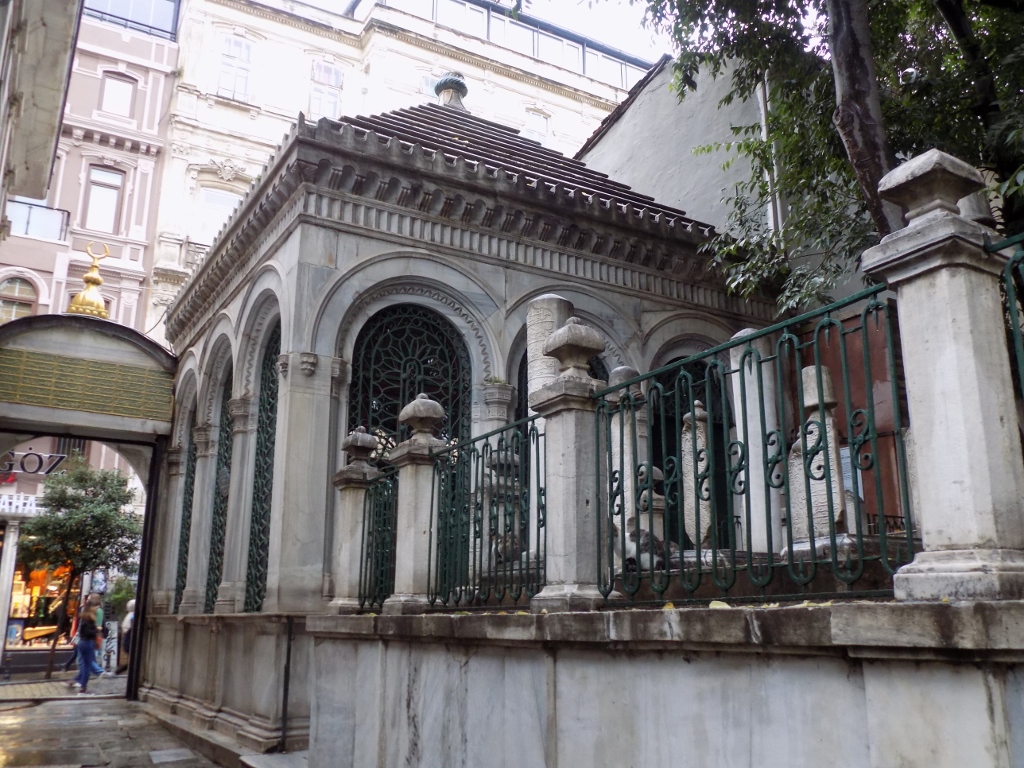 Entrance into the Galata Mevlevihanesi Müzesi
Entrance into the Galata Mevlevihanesi Müzesi
In order to see dervishes whirl, it is possible to come here to the museum as well, but as far as I understood this is organised here only on Sunday evenings. On the other days it is necessary to go to one of the cultural centres that organise a one-hour show for tourists mostly with chanting, but certainly also with the whirling, since this is what visitors actually want to see.
Not far from this museum starts the Istiklal street, one of the best known streets in Istanbul. This is an elegant street full of shops, but apart from being for pedestrians only in principle, this is also the route of yet another picturesque part of the city’s public transportation and this is the “historic tram,” i.e., the T2 tram line.
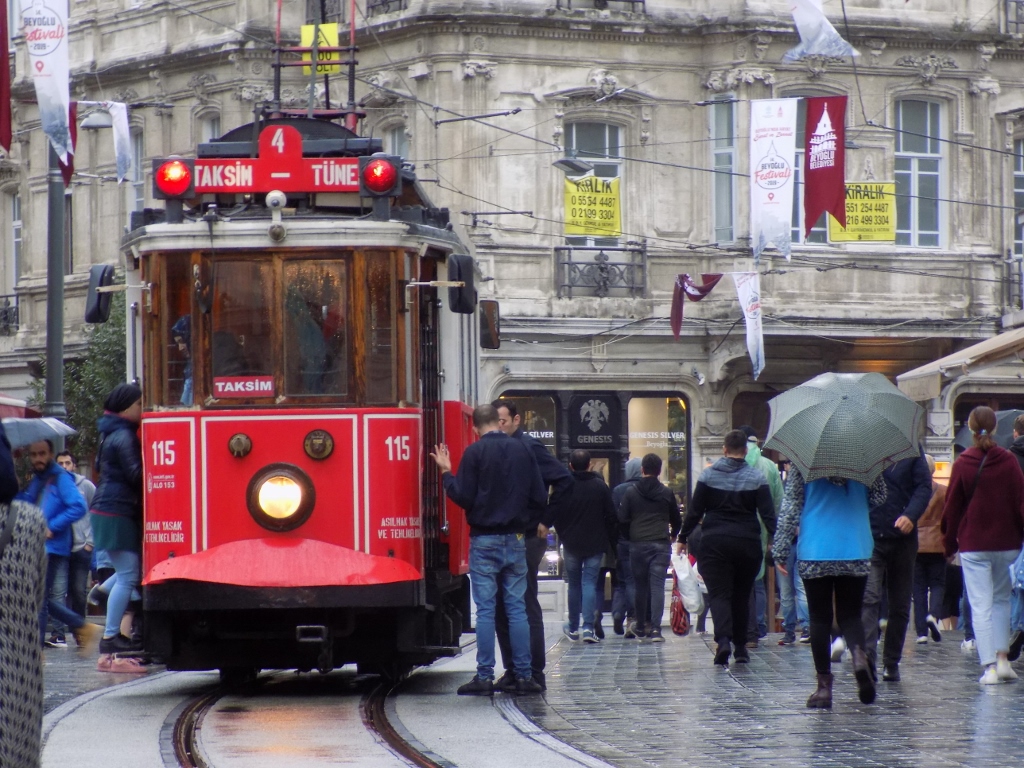 “Historic tram” in the Istiklal street
“Historic tram” in the Istiklal street
We were here in the late afternoon and there were a lot of people in the street and consequently in that tiny tram, so we did not even try to get in, rather opting to cover on foot the entire length of the Istiklal street which is 1.4 km. Although there are numerous shops with wardrobe, many of which may also be seen in other cities in the world, I was somehow mostly drawn by shop windows exhibiting food.
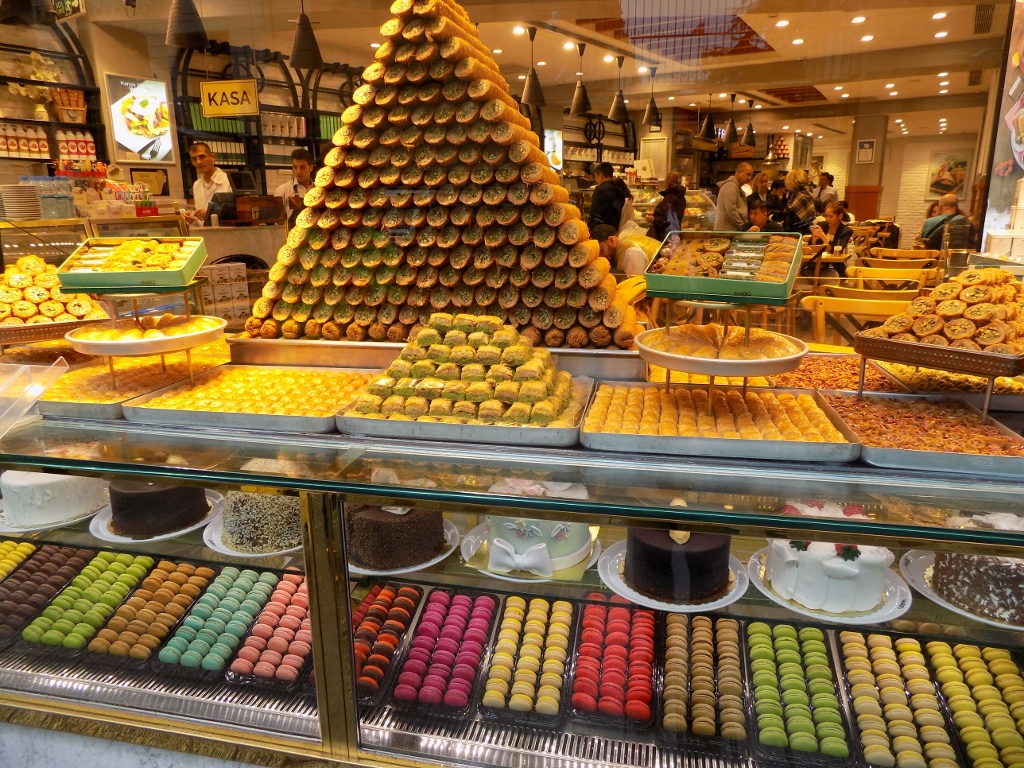 One of pastry shops in the Istiklal street
One of pastry shops in the Istiklal street
Admittedly, as I love pottery, I certainly found very interesting the numerous bowls that also brought colour into this gray day.
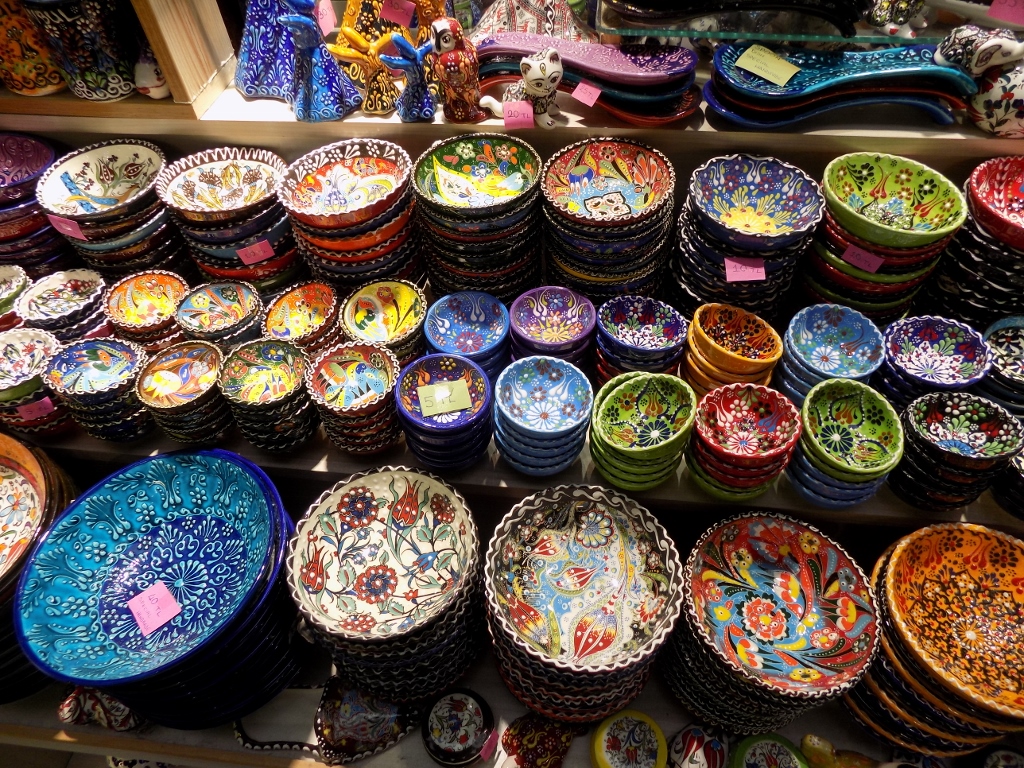 Exhibited bowls in the Istiklal street
Exhibited bowls in the Istiklal street
At this point in time we became rather tired and certainly quite hungry, so we stopped for late lunch at a restaurant in one of the side streets that extend from the Istiklal street. After that break which was slightly longer, we walked slowly to the Taksim Square, but we were no longer interested in visiting anything else. So, we just went down the hill to the shores of the Bosphorus where we caught a tram (a modern, not a historic one) and transferred in this way to the part of the city where we had a hotel room where I just had a shower and went to bed immediately.
The following day was again planned very ambitiously (since I was the one in charge of the development of the plan, I have nobody else to blame nor can I find any excuse, except that I thought there was so much to see in Istanbul that one simply had to fit into the daily schedule as much as possible). So, here is the map for this day:
Still, this day started brightly, with an almost cloudless sky and that certainly felt good in comparison to the previous one that was all gray and rainy. By this time quite well versed in the city’s public transportation, we caught a bus that suited us and went to its last stop from where we just had to walk a little bit to the Chora Museum, i.e., to the Chora Church.
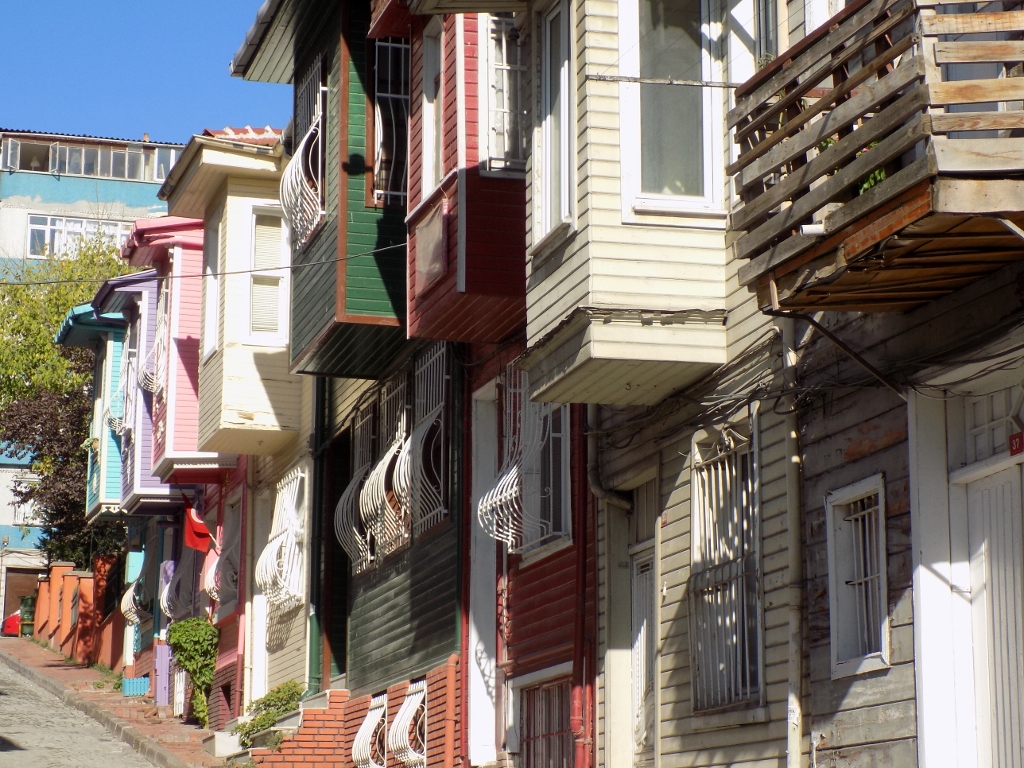 A street in the direct vicinity of the Chora Museum
A street in the direct vicinity of the Chora Museum
Well, now, if somebody asks me, although relatively off the beaten tracks in comparison to the other places in the city and a little away from the centre, the Chora Museum is something not to be missed at all during a visit to Istanbul. This is a church in fact and the original edifice of the church is presumed, precisely because of its name, to have been built in this very place already at the beginning of the 4th century as a part of a monastery complex. Since the church was located outside the city walls built by Constantine the Great it was named the Church of St. Saviour in the Fields (rough translation), because it was, apparently, outside the limits of the then city. It is precisely that Greek word that marks a country-side (as opposed to the urban core), i.e., the fields in this translation, that is “Chora” and this name has stuck to the place to the present days although already with the construction of the walls of Emperor Theodosius II from 413 to 414 the monastery got incorporated into the city.
Needless to say, after the Ottoman conquest, the church was turned into a mosque, but in 1948 it was declared a museum and it was then that the plaster covering the original decoration was removed. Following the restoration today it is possible to see here some of the oldest and most beautiful Byzantine mosaics.
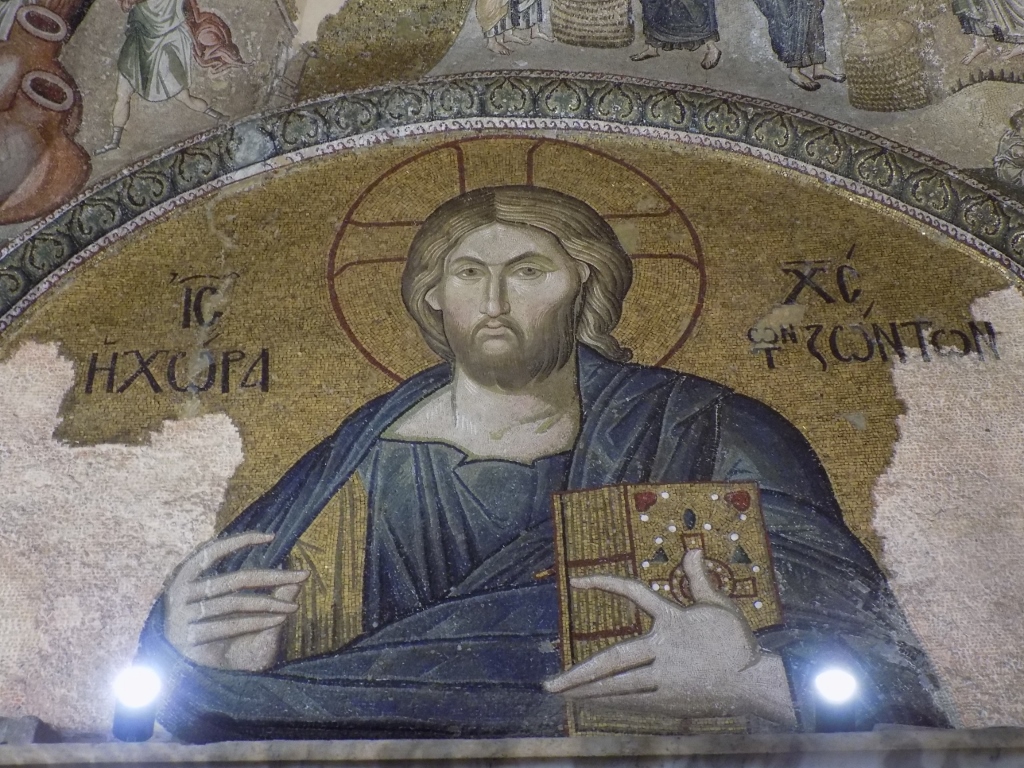 Chora Museum
Chora Museum
The mosaics in the area of the narthex are particularly impressive.
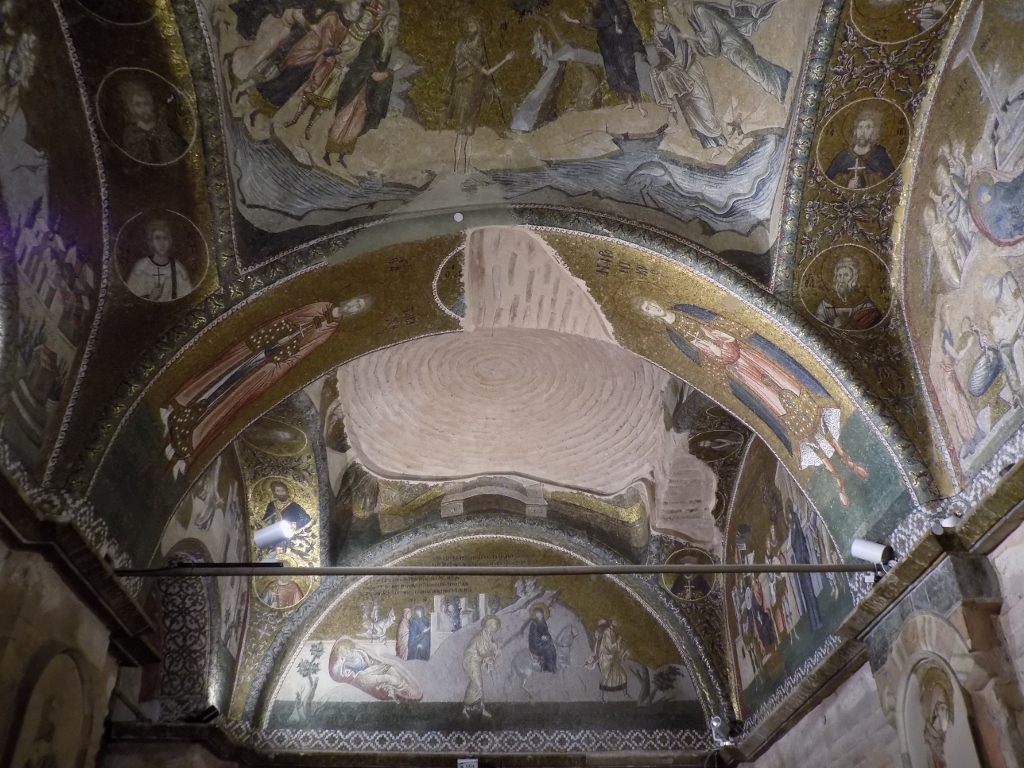 Chora Museum, the narthex
Chora Museum, the narthex
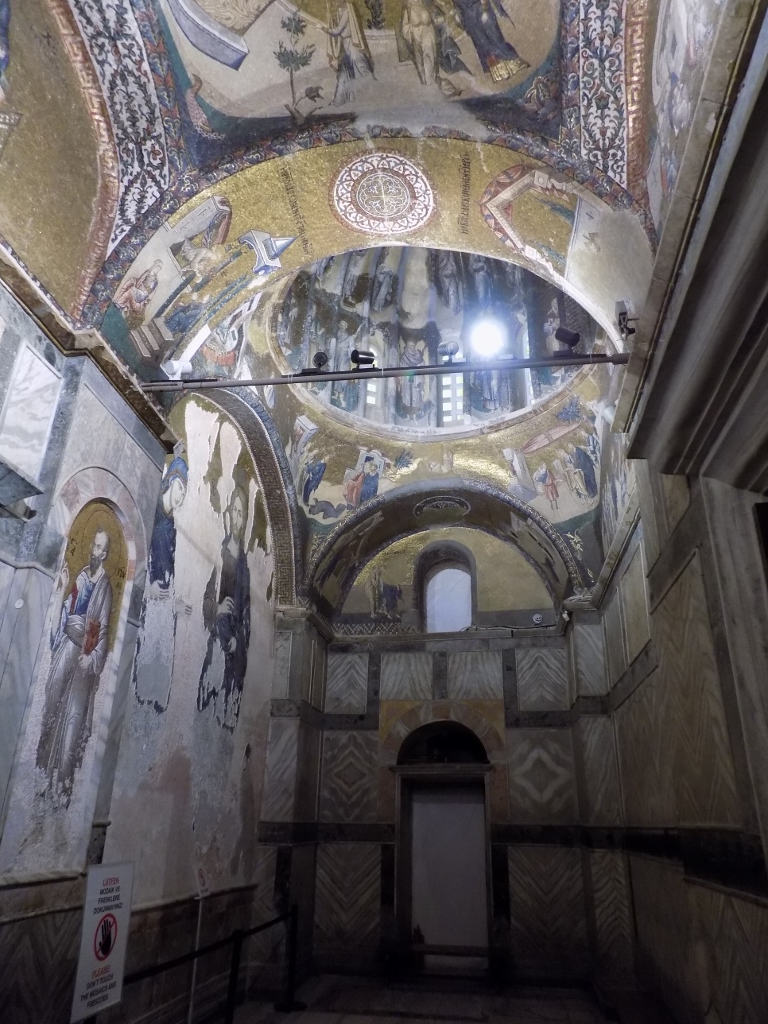 Chora Museum, the narthex
Chora Museum, the narthex
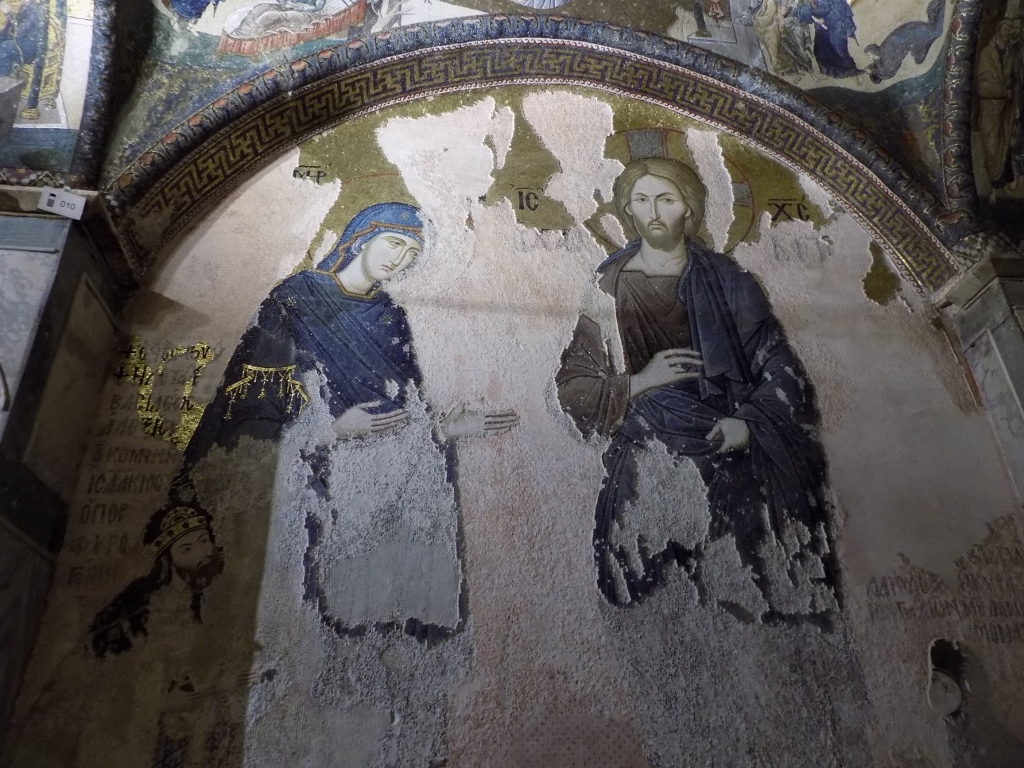 Chora Museum, the narthex
Chora Museum, the narthex
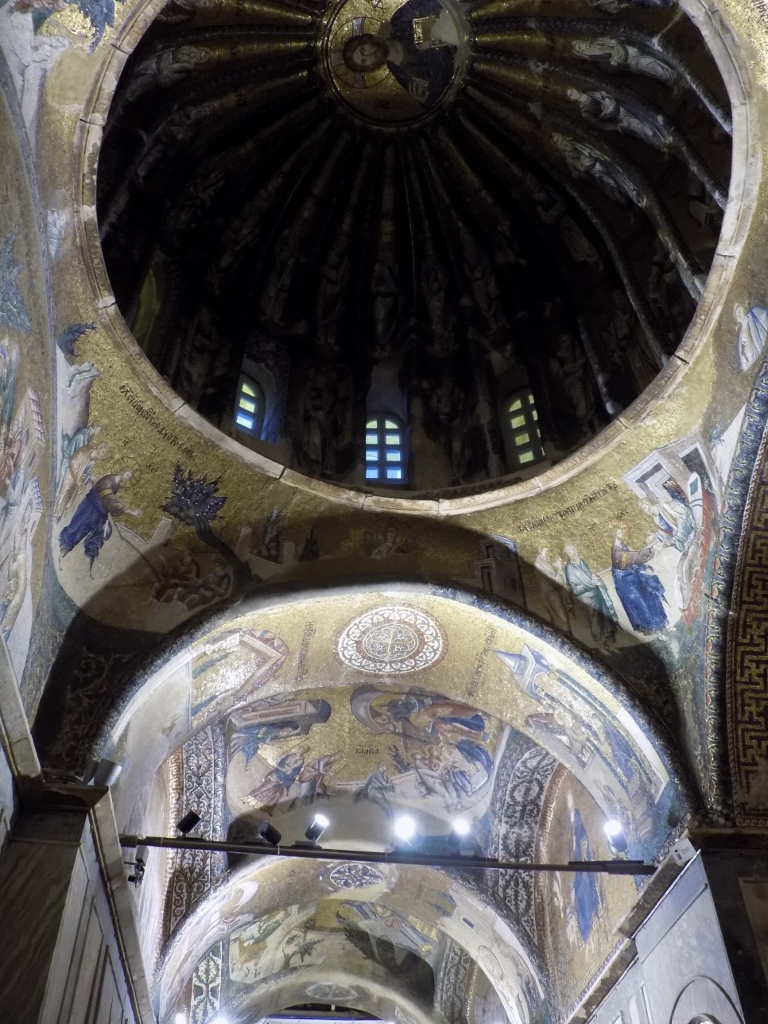 Chora Museum, the narthex
Chora Museum, the narthex
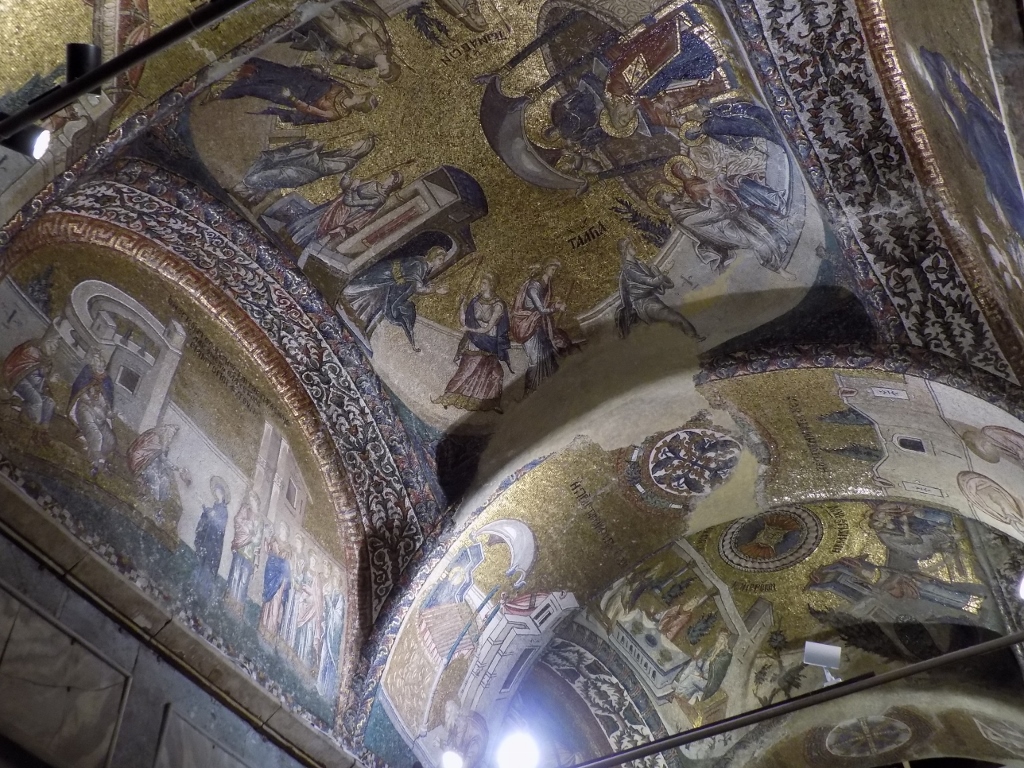 Chora Museum, the narthex
Chora Museum, the narthex
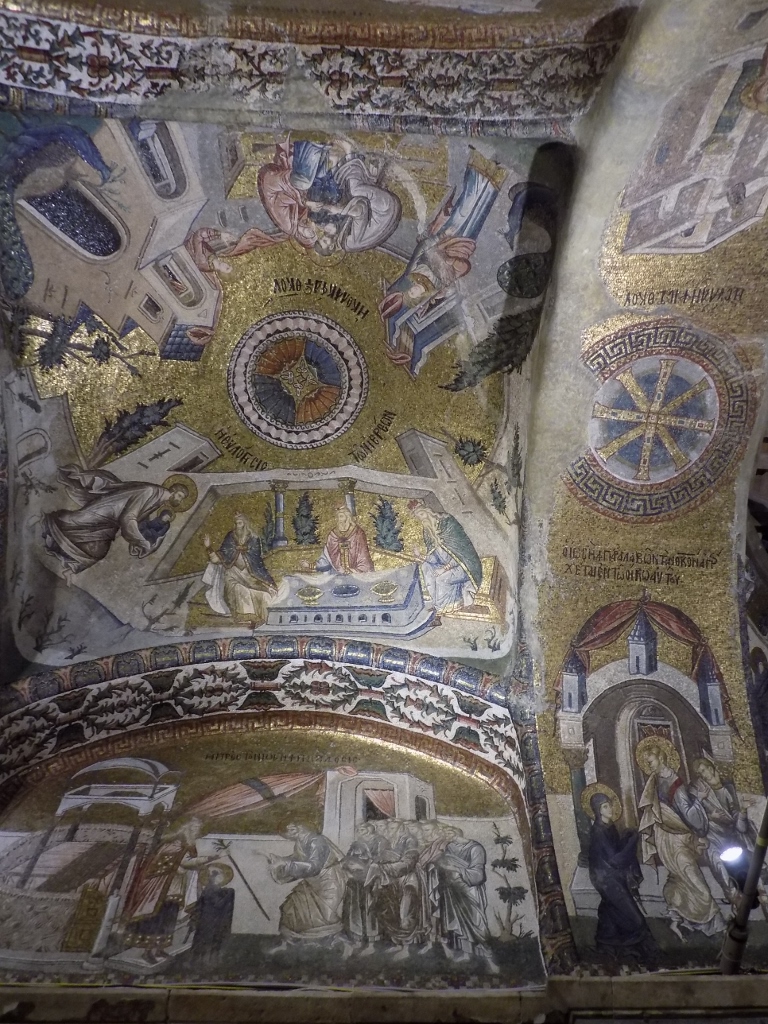 Chora Museum, the narthex
Chora Museum, the narthex
Although, the area of the naos is certainly not negligible.
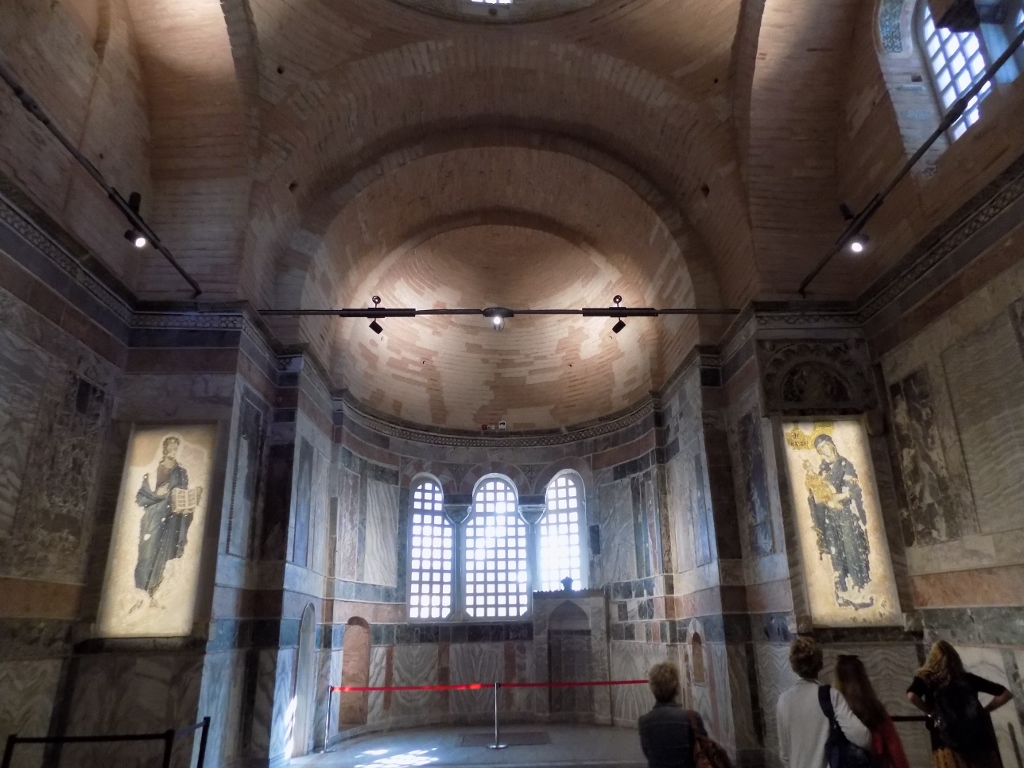 Chora Museum, the naos
Chora Museum, the naos
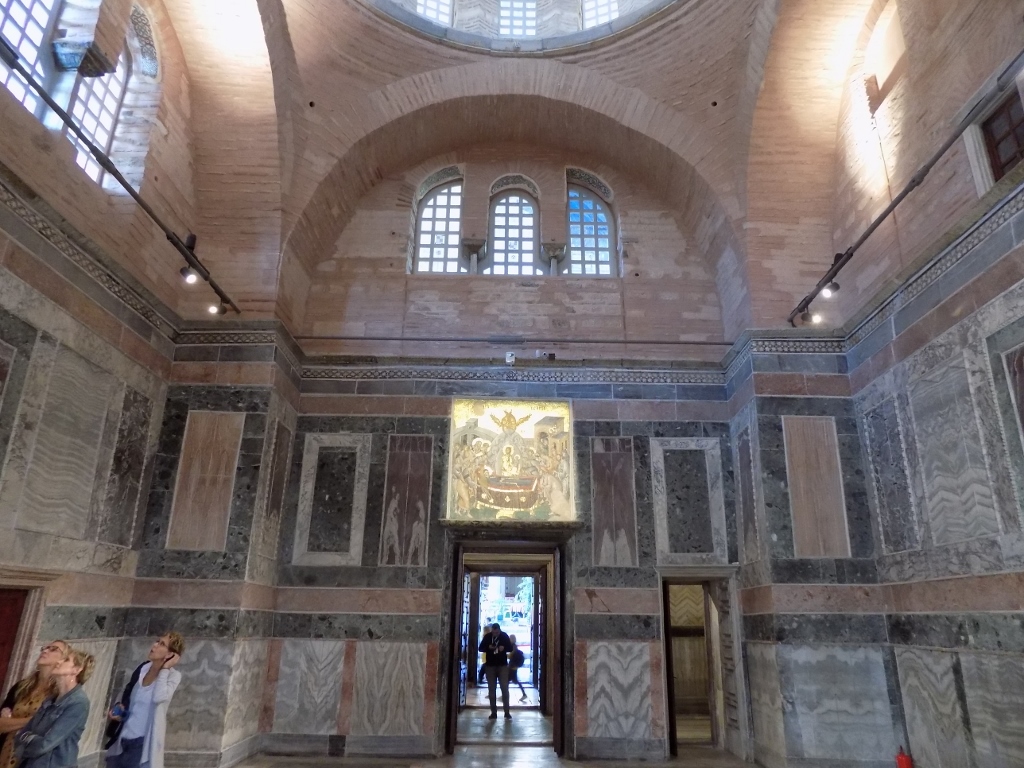 Chora Museum, the naos
Chora Museum, the naos
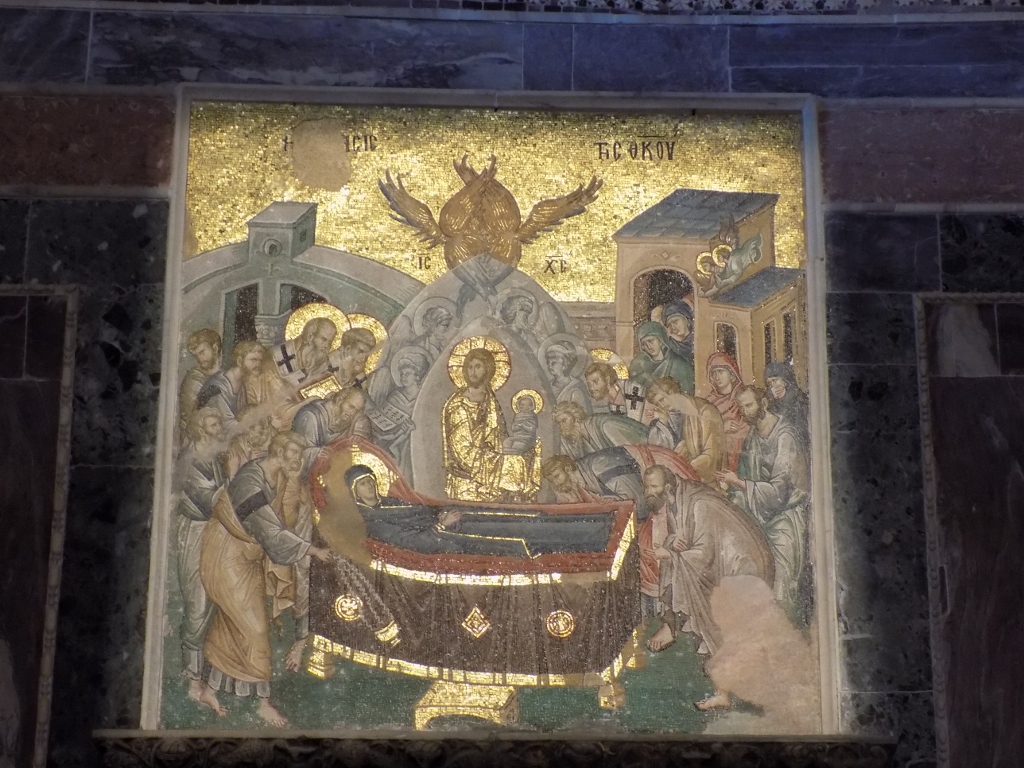 Chora Museum, a detail of a mosaic from the naos
Chora Museum, a detail of a mosaic from the naos
Then we walked to the Fethiye Museum which is also called the Fethiye Mosque, as well as Pammakaristos Church. It is an edifice built between the 11th and the 12th centuries, and it is one of the most famous Orthodox Byzantine churches in Istanbul which after Hagia Sophia and Chora Church has the most mosaics. For a while (15th to the 16th century) it was also the seat of the Ecumenical Patriarch, but then it was turned into a mosque. Today, it is partially a museum and partially a parakklesion.
We had a very clear intention of visiting this museum-church and when we got there we had to walk around looking for the entrance, but then we saw that the site was closed because of the restoration. A couple of months later, when I was writing this text, I saw that the site was opened and I wondered if the two of us were at the right place. However, since Istanbul certainly merits several visits I’m not too worried – this is a nice addition to a new list of the places that have to be visited the next time I go to this truly magnificent city.
So, we continued with our walk in this gorgeous weather and soon we were at our next destination and that was the Yavuz Sultan Selim Mosque, Yavuz meaning ferocious or inflexible.
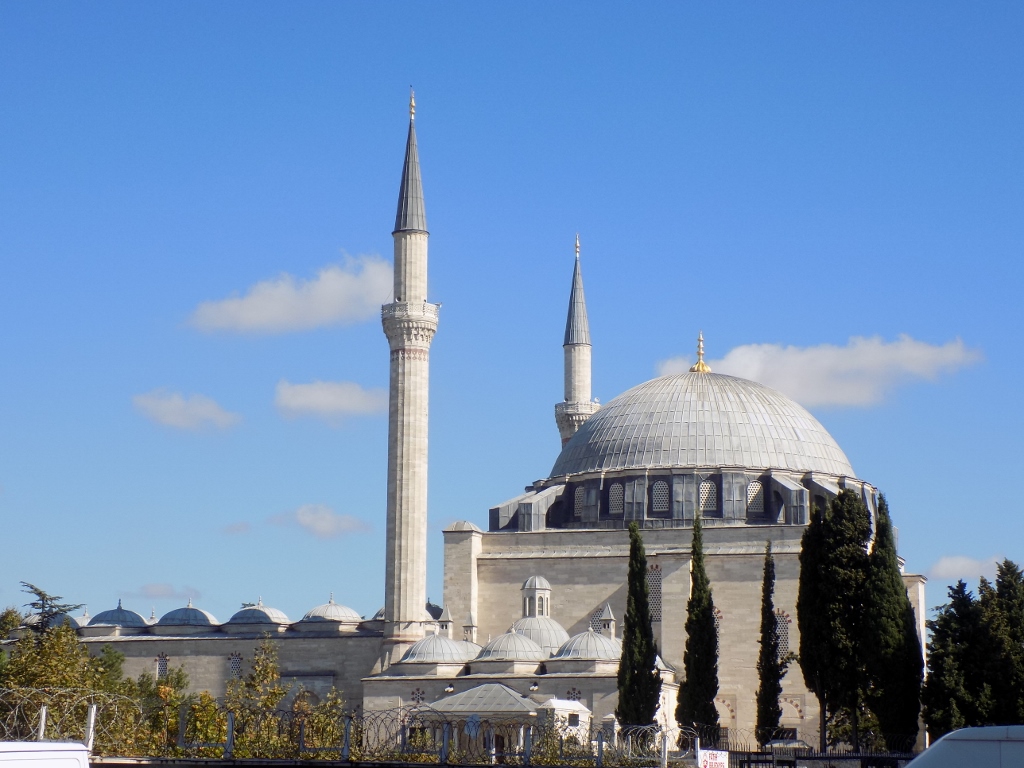 Yavuz Sultan Selim Mosque
Yavuz Sultan Selim Mosque
At the beginning of the 16th century, Sultan Selim I ruled rather briefly – only eight years. Still, he is a much respected sultan as it is considered that he has achieved a lot and has practically prepared a very good base for the peak of the Ottoman Empire that was reached during the reign of his son and heir, and that was Suleiman the Magnificent. But, Selim I was also a very ruthless ruler and in addition executing numerous viziers, he is also responsible for the death of two of his brothers, several of his nephews and even three of his very own sons first in order to ensure his own reign and then that of his chosen heir – Suleiman I. It was precisely Sultan Suleiman the Magnificent who had this mosque built to honour his father. Fair enough!
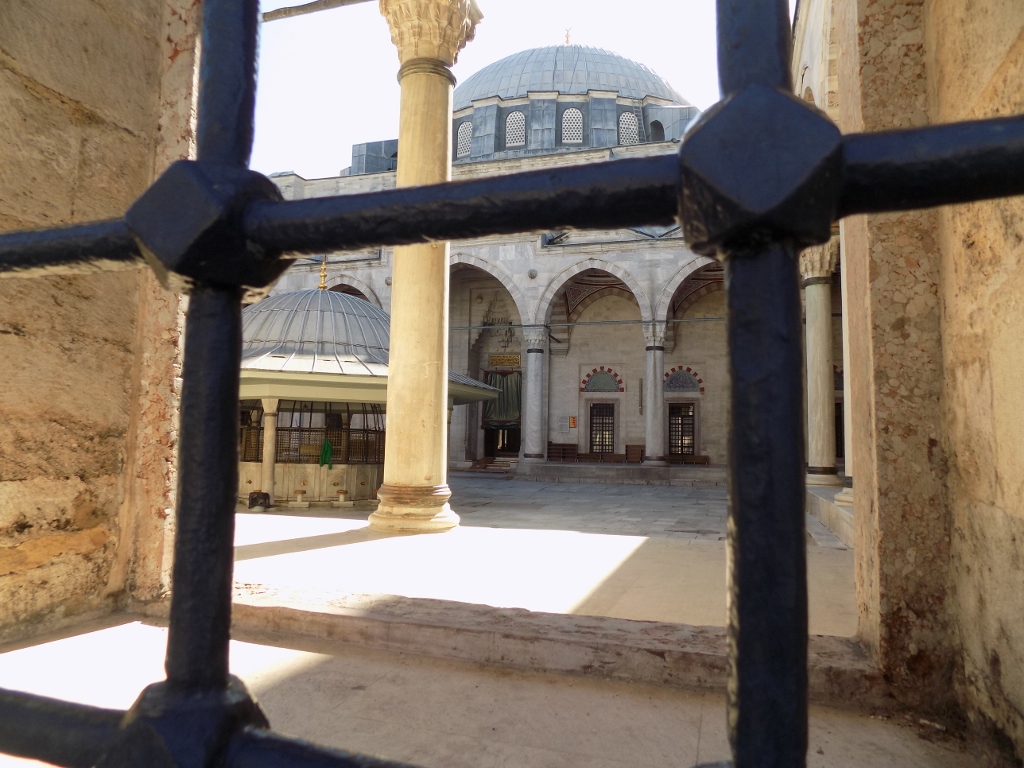 Yavuz Sultan Selim Mosque: when you peer at the courtyard with the shadirvan
Yavuz Sultan Selim Mosque: when you peer at the courtyard with the shadirvan
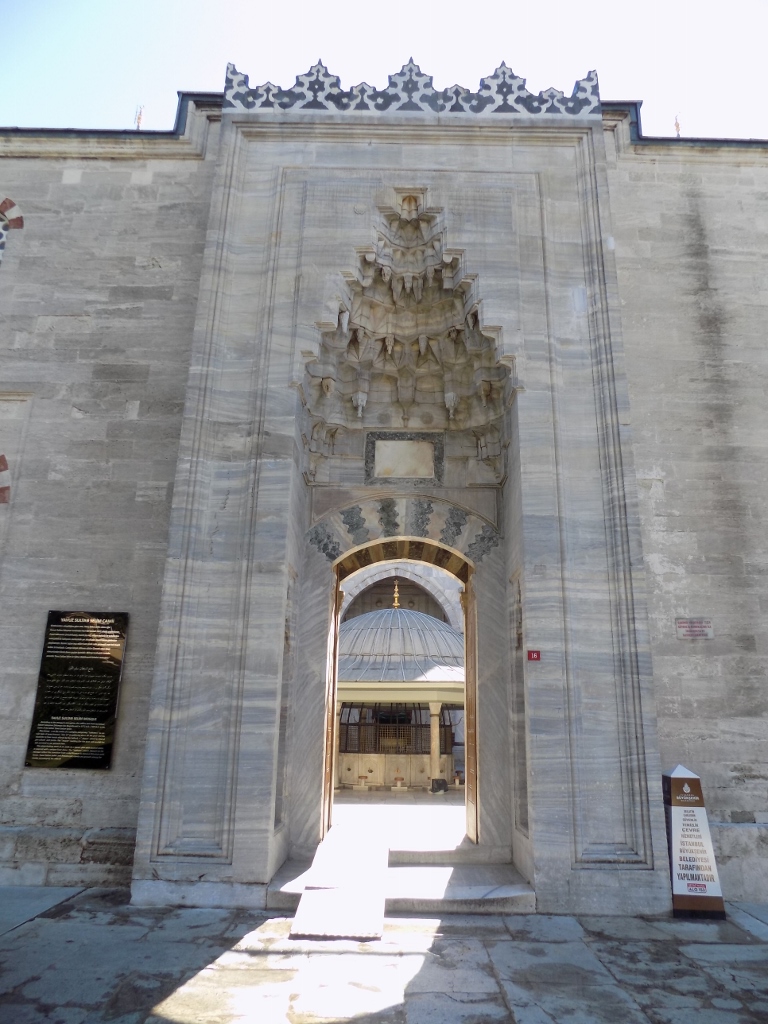 Yavuz Sultan Selim Mosque: entrance into the mosque’s courtyard with the muqarnas
Yavuz Sultan Selim Mosque: entrance into the mosque’s courtyard with the muqarnas
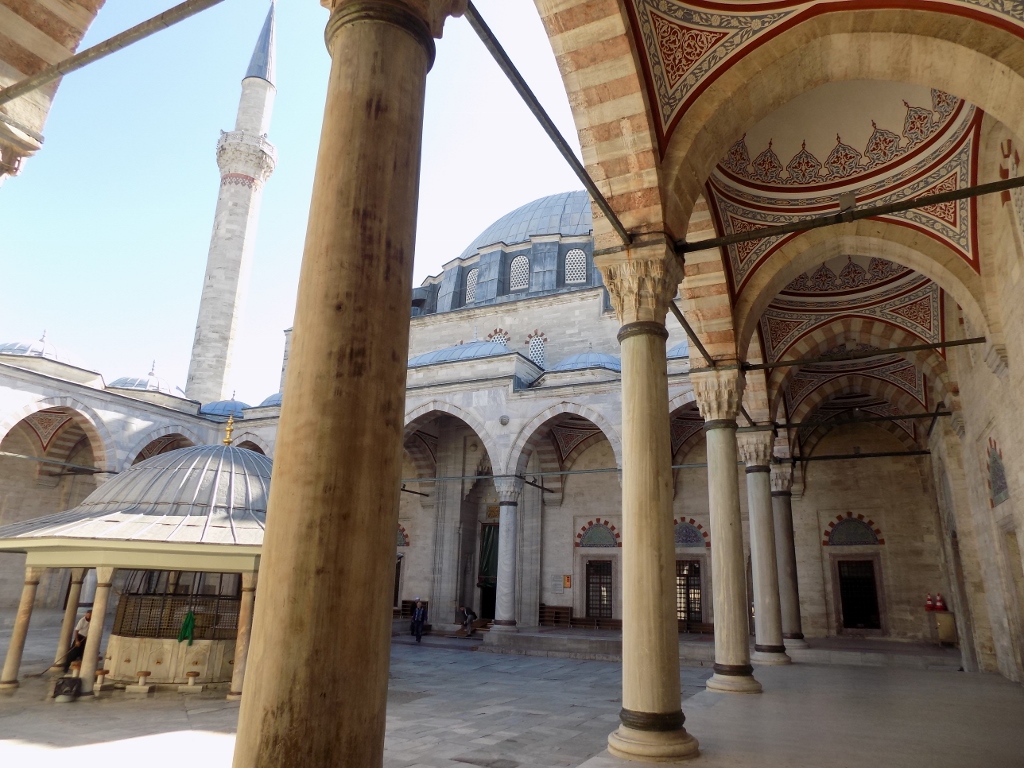 Yavuz Sultan Selim Mosque: courtyard with the shadirvan and the colonnaded portico
Yavuz Sultan Selim Mosque: courtyard with the shadirvan and the colonnaded portico
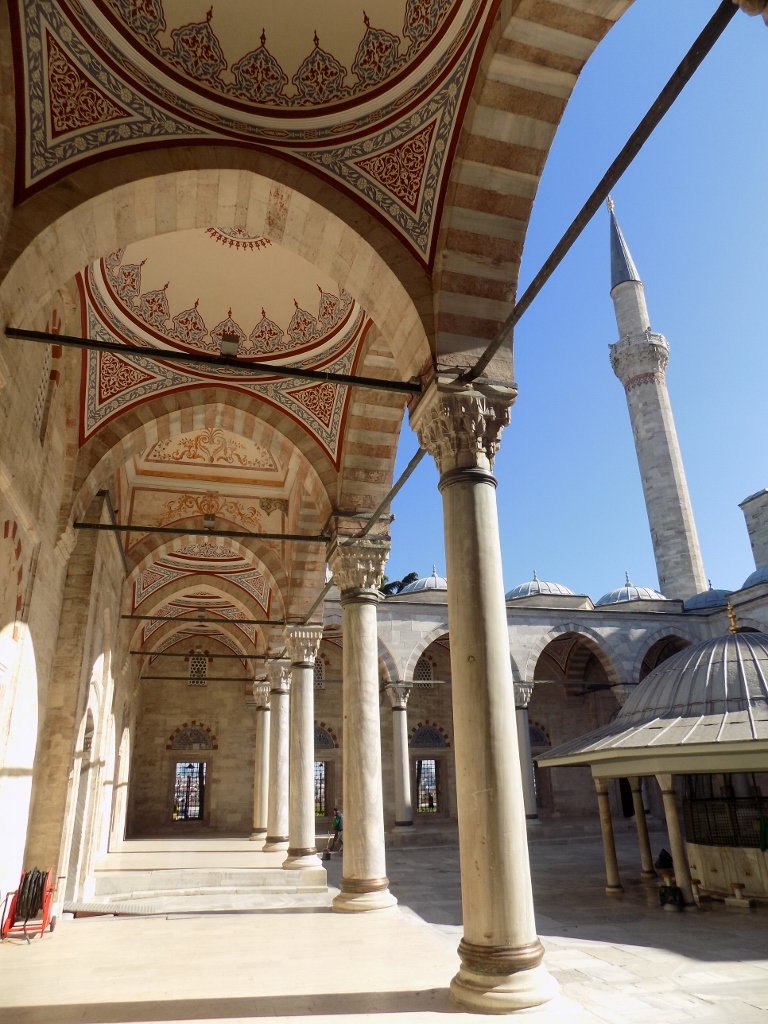 Yavuz Sultan Selim Mosque: the portico and a part of the courtyard
Yavuz Sultan Selim Mosque: the portico and a part of the courtyard
According to what I have read, with time this mosque has been neglected a little, but at the beginning of 2009 it was restored. Be as it may, the impression after entering the praying hall was truly stunning.
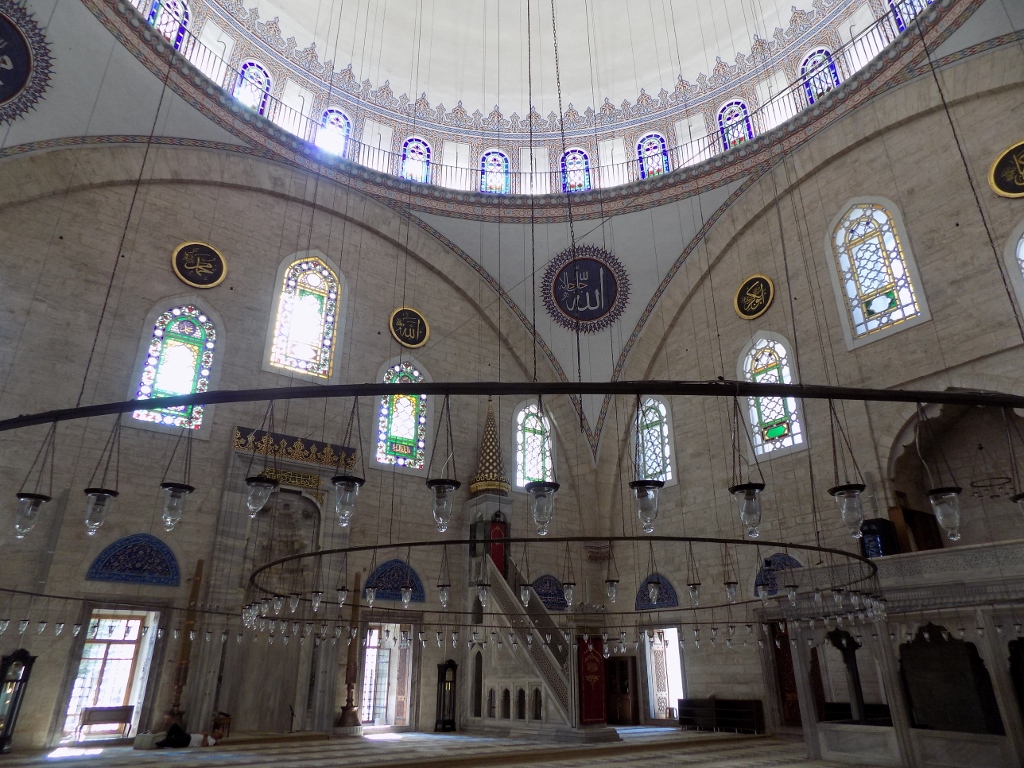 Yavuz Sultan Selim Mosque: the interior
Yavuz Sultan Selim Mosque: the interior
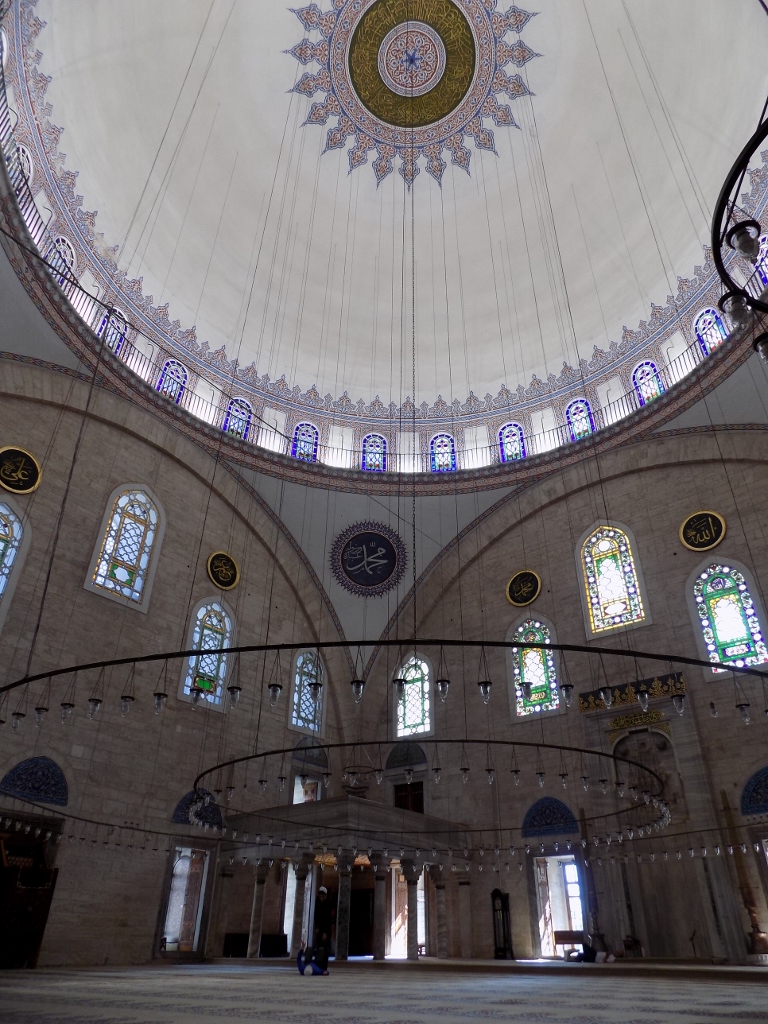 Yavuz Sultan Selim Mosque: the interior
Yavuz Sultan Selim Mosque: the interior
What caught my eye the most are the lunettes made of tiles.
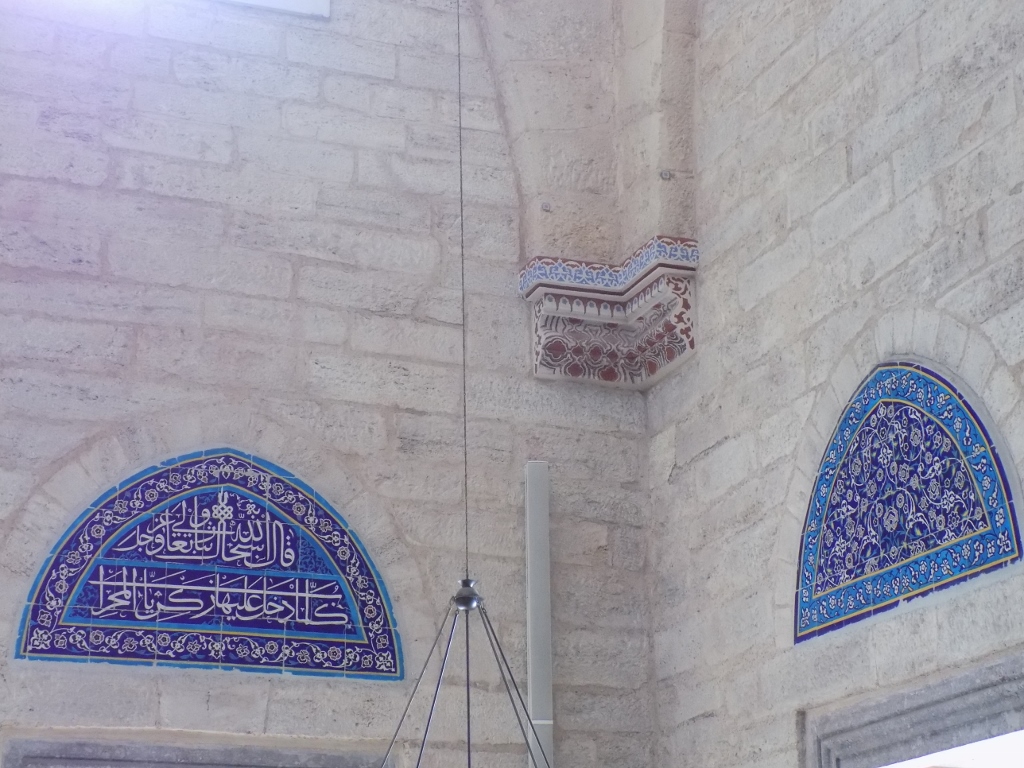 Yavuz Sultan Selim Mosque: tile lunettes
Yavuz Sultan Selim Mosque: tile lunettes
Following our brief stay at the mosque, we went out through one of the side doors that led from the courtyard onto a plateau from which there is a superb view at the Golden Horn bay.

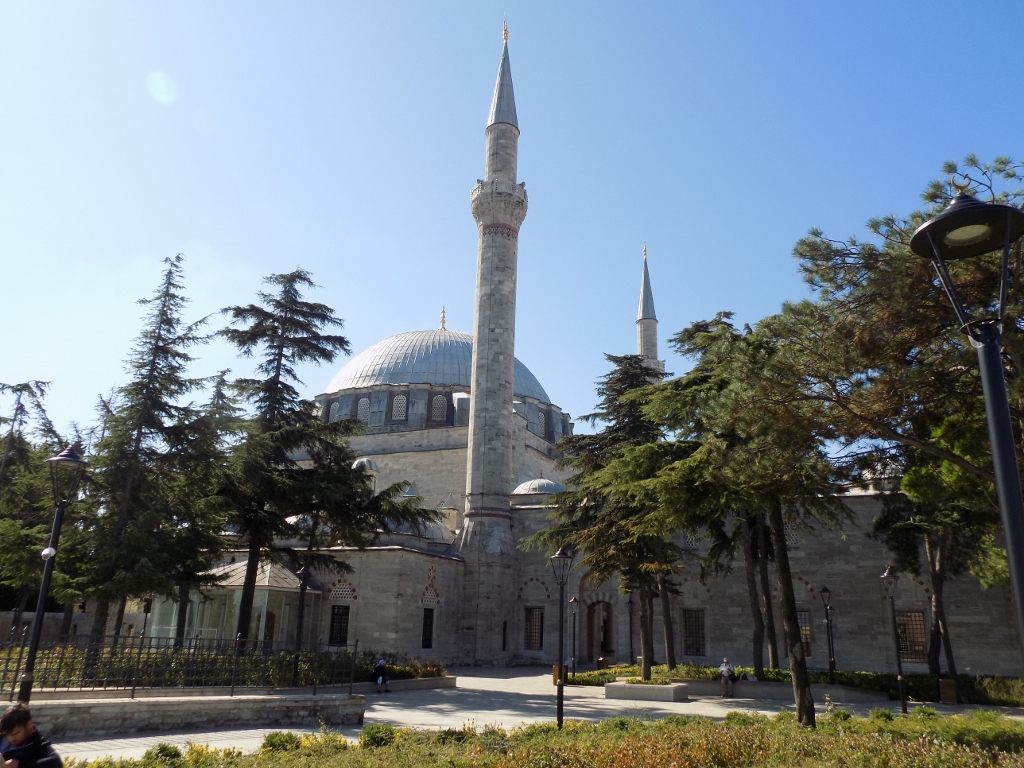 View from the plateau at the Yavuz Sultan Selim Mosque
View from the plateau at the Yavuz Sultan Selim Mosque
And then we also walked to a courtyard that is located behind the mosque and this is the place where there is the türbe, i.e., the grave of Sultan Selim I, as well as his wife Hafsa Sultan who was the mother of Suleiman I. In this courtyard there is also the tomb of Sultan Abdulmejid who ruled in the 19th century (he built the Dolmabahçe Palace).
I must admit that for me the most striking was the view which from this courtyard as well extends towards the Golden Horn and the bridges that cross it.
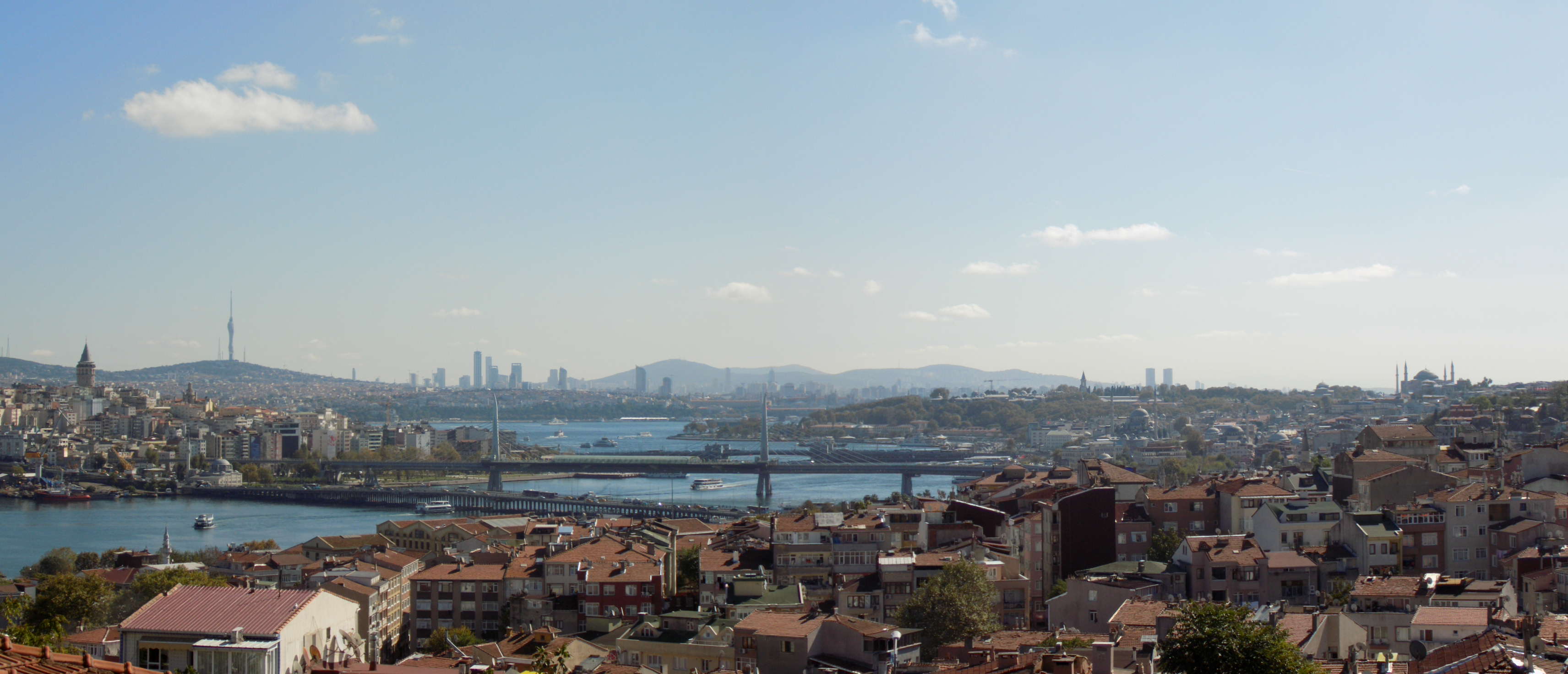
While we were walking from one tomb to the next, we came across an elderly man who was walking around with two little girls; he seemed like a granddad who was taking his granddaughters for a walk. At some point he approached Sneža and I and gave each one as a gift a large walnut in a shell and a piece of paper where something has been written in Latin. He also kept saying something, but of course we did not understand him at all. Later, when we were in our hotel room, I looked again at those inscriptions – “la ilaha illallah” and “muhammadur rasulullah” – and then I found out that this meant the following: “There is no god but God” and “Muhammad is the messenger of God.” I am not a Muslim, but the gesture and the energy of this man seemed very positive and well-intentioned, so I kept as a souvenir from Istanbul both this walnut and that piece of paper – since I see them as a blessing of a sort.
As a pure coincidence, we happened to walk and visit sights in this neighbourhood on a Wednesday and Wednesday is the market-day in the area between the Yavuz Sultan Selim Mosque and the Fatih Mosque.
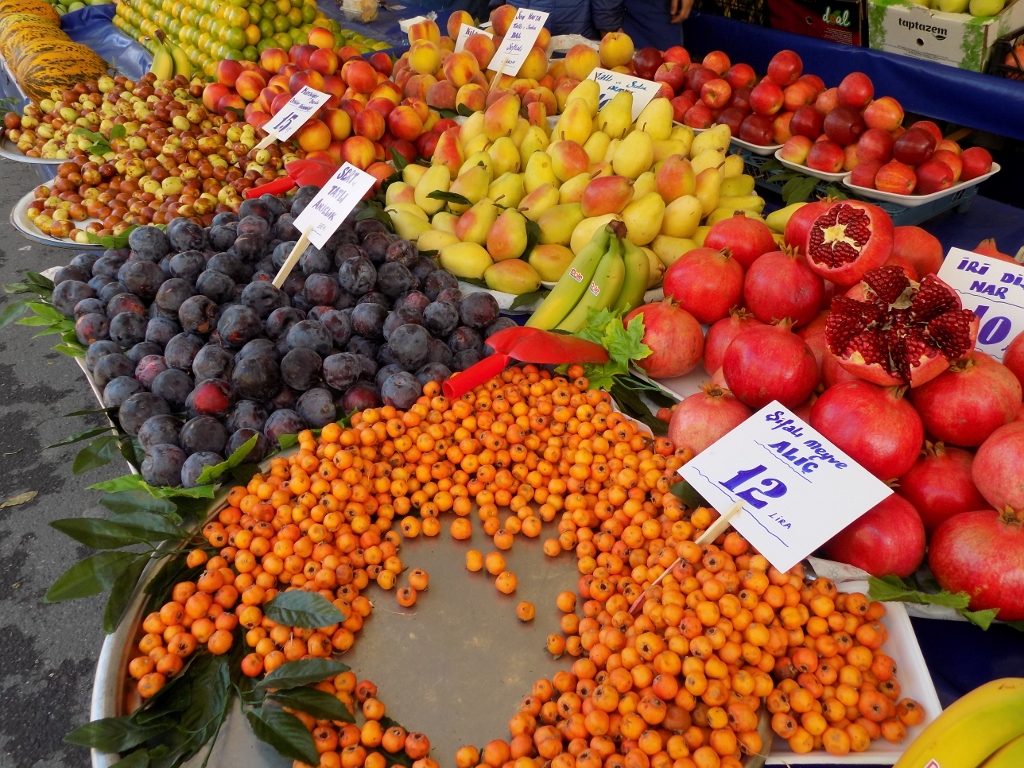 Market in Fatih municipality
Market in Fatih municipality
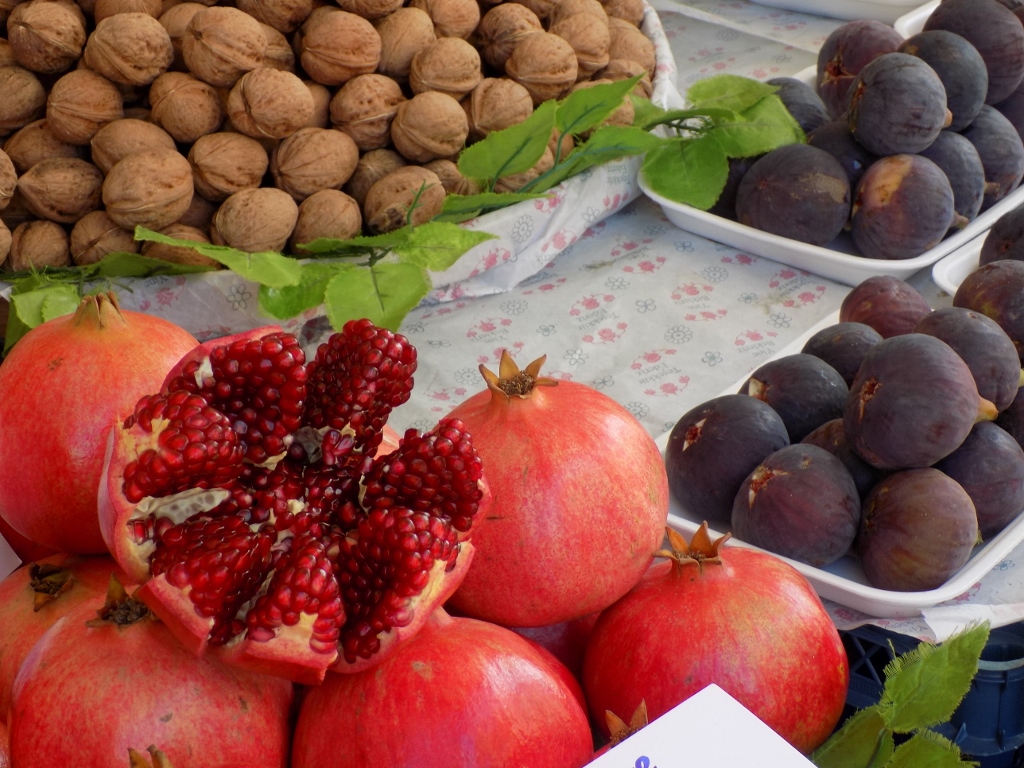 Market in Fatih municipality
Market in Fatih municipality
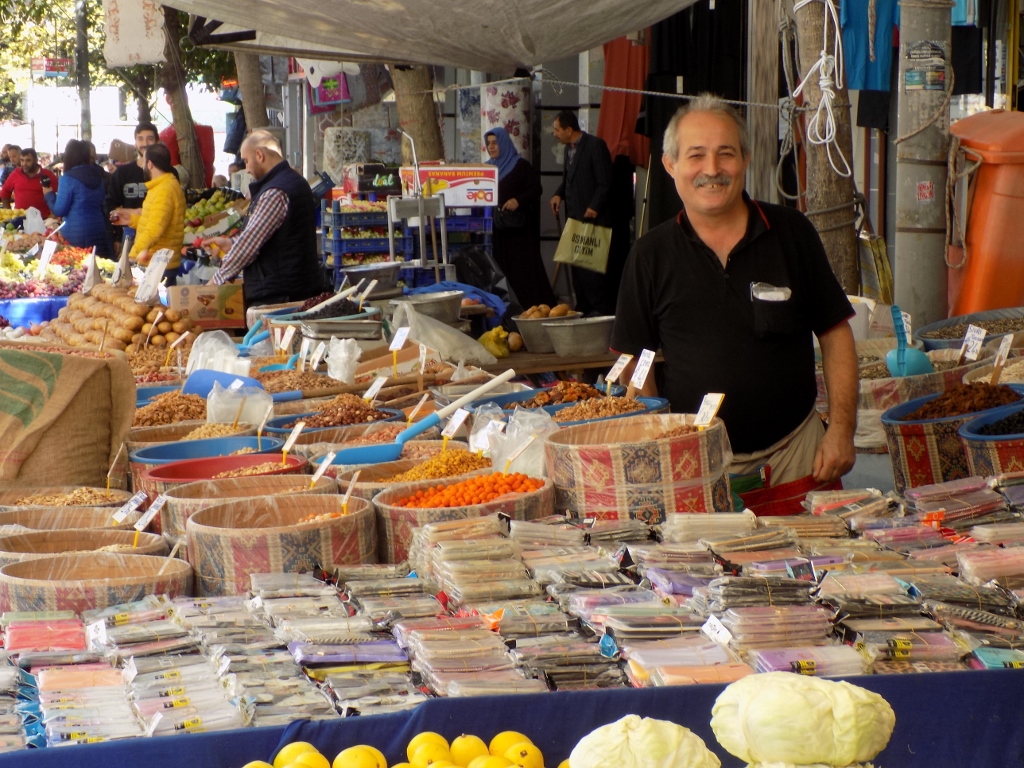 I was actually taking photo of the stall, but the vendor posed so nicely and with such a broad smile on his face that I had to include him in the photo, too
I was actually taking photo of the stall, but the vendor posed so nicely and with such a broad smile on his face that I had to include him in the photo, too
In addition to the fantastically bright-coloured fruits primarily, the market also offers vegetables, different olives, seasonings, nuts and dried fruits, as well as many other things – bed linen, pyjamas, underwear and all sorts of clothes. We simply did not know where to look first since everything was so interesting, attractive and colourful. And then we saw the Fatih Mosque in front of us.
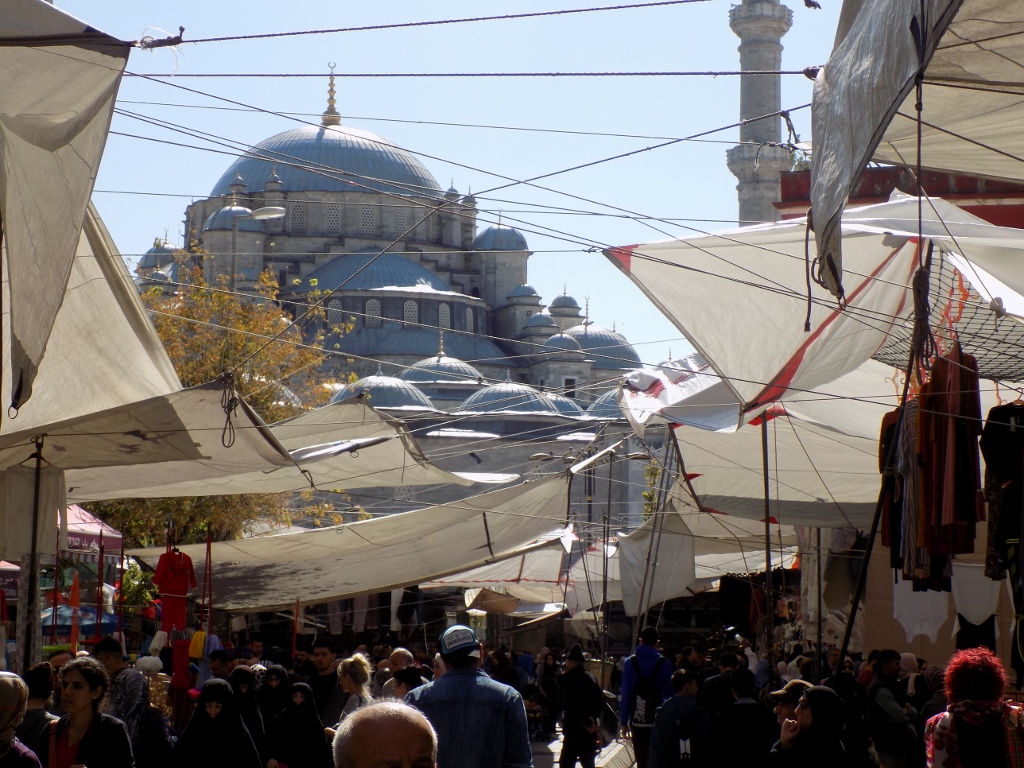 Fatih Mosque and parts of the market in Fatih
Fatih Mosque and parts of the market in Fatih
The Fatih Mosque means the Conqueror’s Mosque and the name is fully appropriate since it was built in the 15th century by Mehmet the Conqueror who conquered Constantinople in 1453.
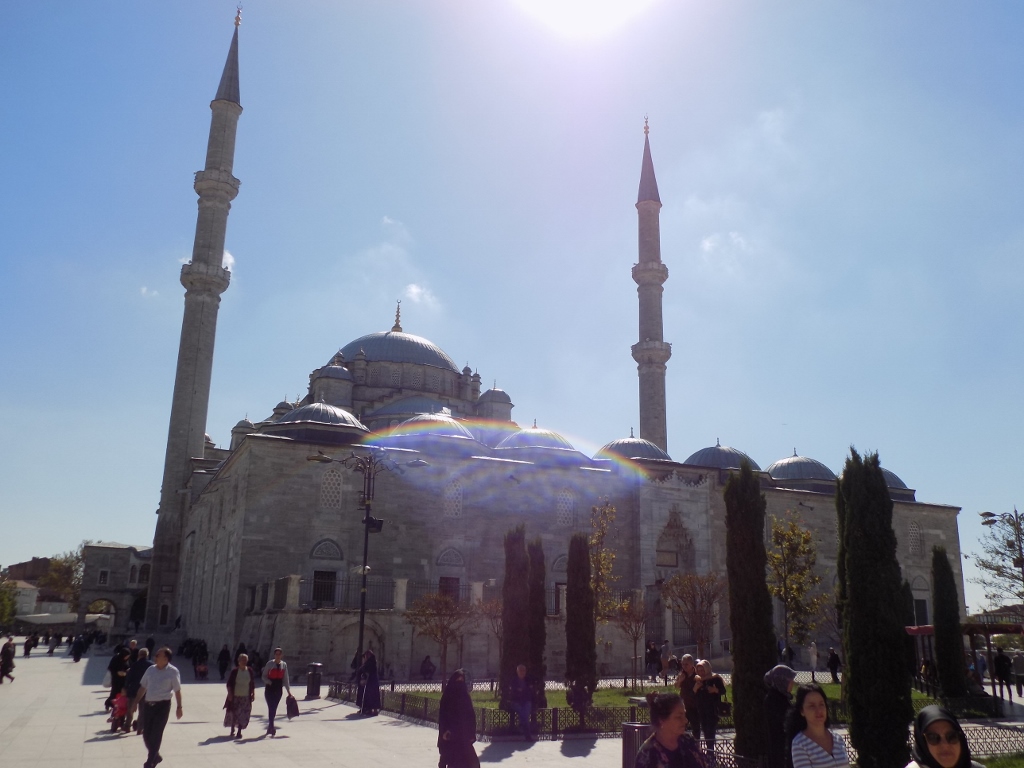 Fatih Mosque
Fatih Mosque
By the way, a grandson of Mehmet the Conqueror was Sultan Selim I whose mosque we had previously visited and that means that a great-grandson of Sultan Mehmet was – Sultan Suleiman the Magnificent. This is just a side note in order for one to get an idea about the dynastic flow in the early Ottoman Empire.
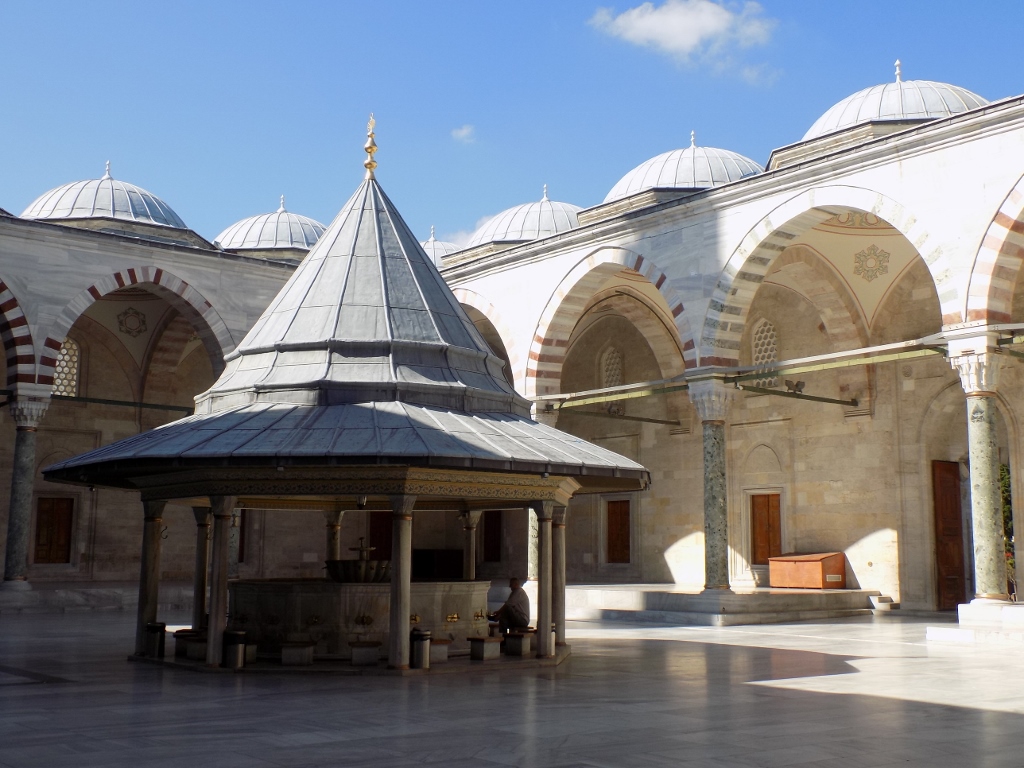 Fatih Mosque: the courtyard with the shadirvan
Fatih Mosque: the courtyard with the shadirvan
Mehmet the Conqueror did not choose this place to build his mosque by accident. Namely, in the past there used to be a church which was admittedly by the time the Ottomans came here already in a rather crumbly state since its demise had been started by Crusaders (!!!) a few centuries earlier – in 1204 to be exact. This church was the place where Constantine the Great was originally buried, but the fate of his remains has been dimmed by the time and historic events, so practically nothing is reliably known about this subject. In addition, this place is on the top of one of the hills of Istanbul, so it was certainly deemed most suitable for building a stunning edifice such as this mosque.
The interior of the mosque is very striking as well and it particularly enthrals with its size and numerous windows that let the bright sunlight of this day into the inner space.
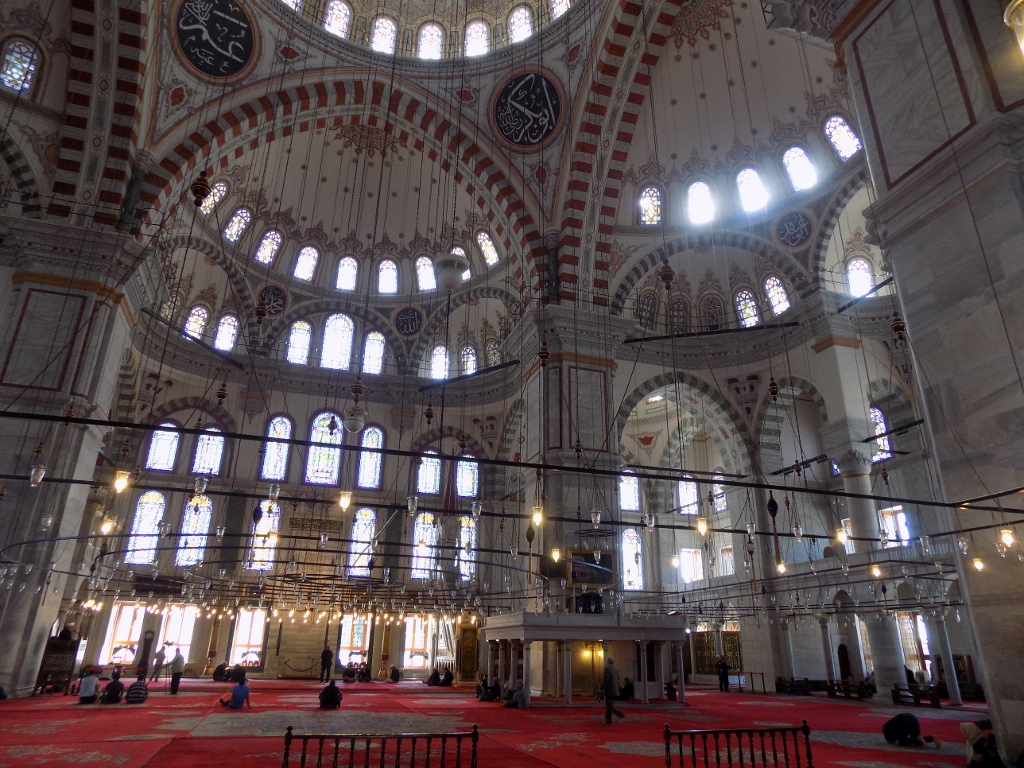 Fatih Mosque
Fatih Mosque
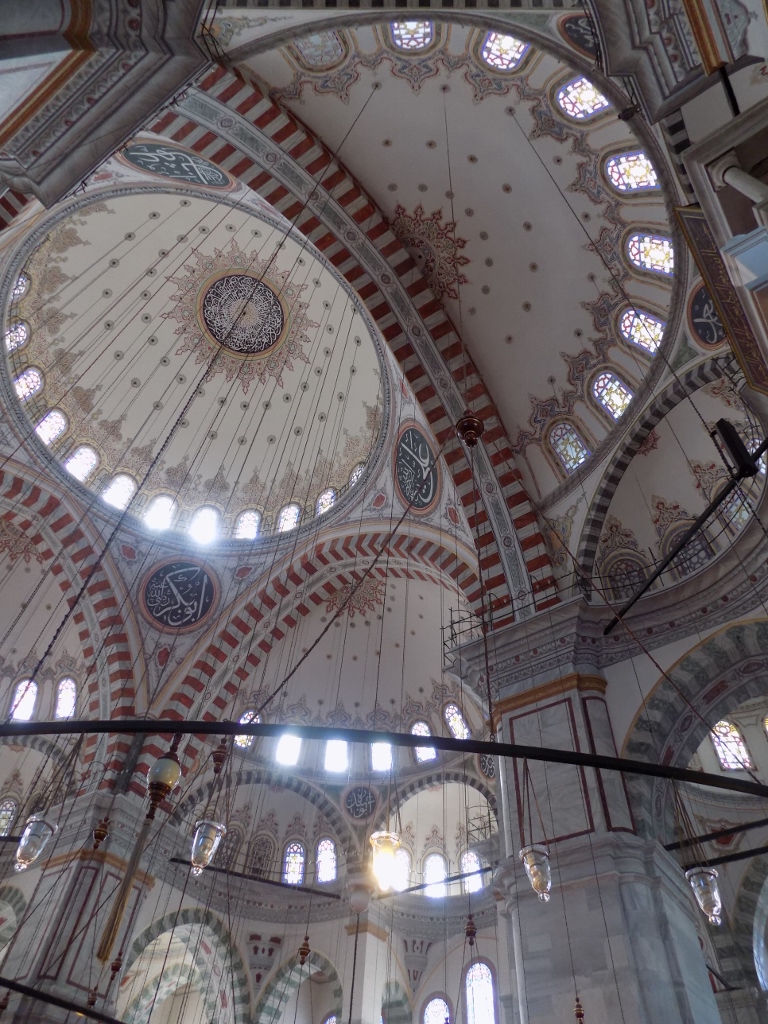 Fatih Mosque
Fatih Mosque
Although positioned quite high, the only piece of data I have managed to find is that the central dome has a diameter of 26 meters, without any mention of the height of the crown. In any case, via four semi-domes, the central dome is carried by four massive pillars.
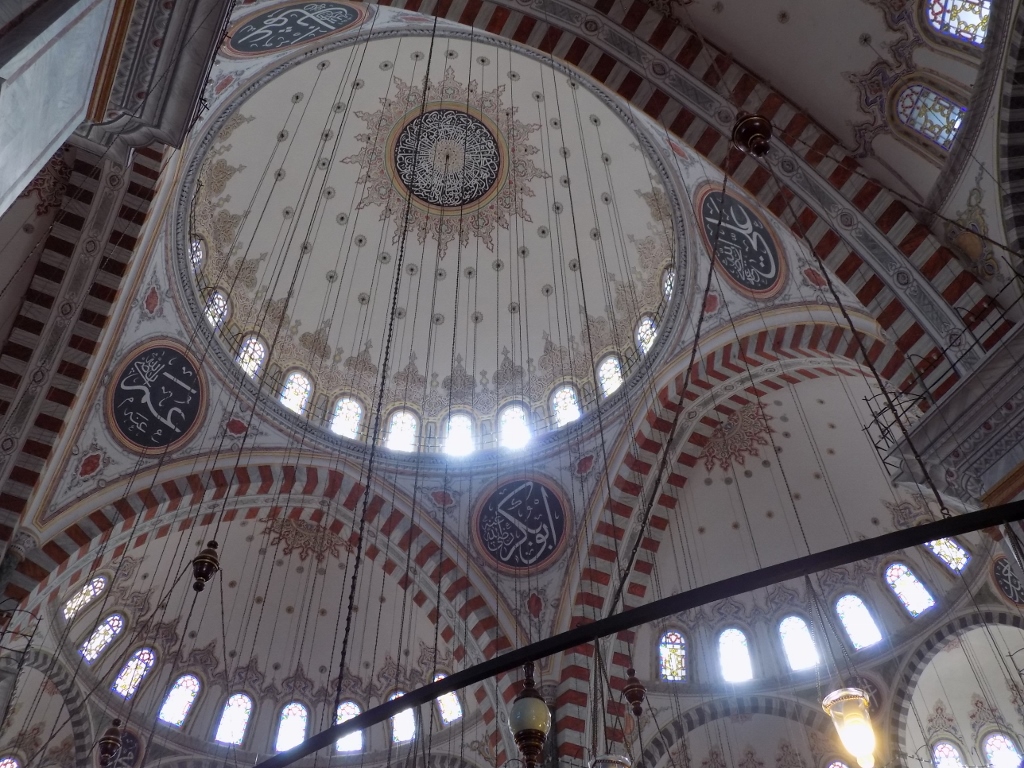 Fatih Mosque
Fatih Mosque
After a short while spent in the mosque, we went out and behind it, since there is a cemetery with the türbe, i.e., the grave of Sultan Mehmet II the Conqueror and his wife.
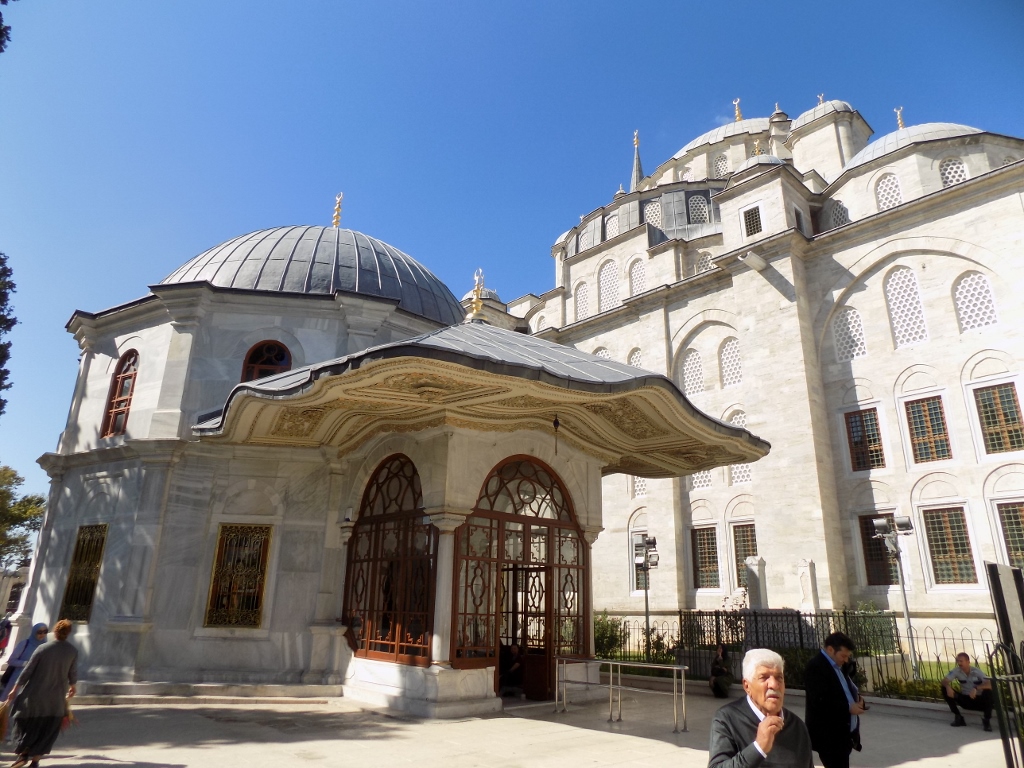 Türbe of Sultan Mehmet II the Conqueror
Türbe of Sultan Mehmet II the Conqueror
Then we continued to walk around the Fatih Mosque and soon we headed further in the direction of yet another magnificent mosque.
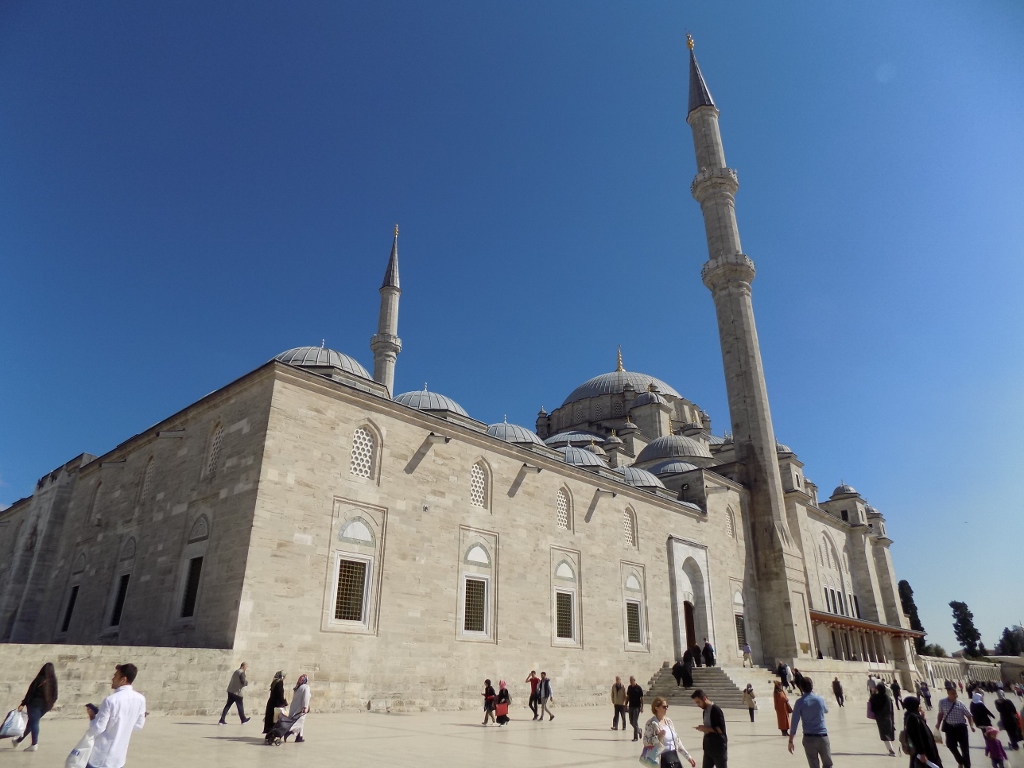 Fatih Mosque lit by the Sun
Fatih Mosque lit by the Sun